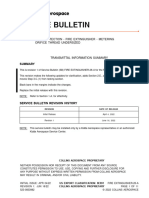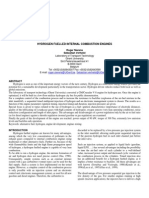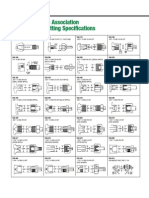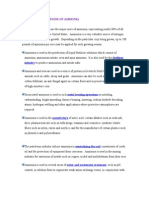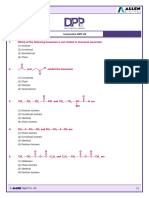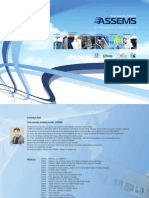0 ratings0% found this document useful (0 votes)
1K viewsCGA Connection Chart
CGA Connection Chart
Uploaded by
staffordnathThis document provides information on standardized valve outlets and connections for compressed gases according to the Compressed Gas Association (CGA). It lists over 50 common industrial and specialty gases along with their associated CGA valve outlet and connection numbers. It notes that Matheson Tri-Gas uses the CGA standardized connections. Lecture bottles for some gases use CGA 170 or 180 connections instead of the standard numbers listed.
Copyright:
Attribution Non-Commercial (BY-NC)
Available Formats
Download as PDF, TXT or read online from Scribd
CGA Connection Chart
CGA Connection Chart
Uploaded by
staffordnath0 ratings0% found this document useful (0 votes)
1K views1 pageThis document provides information on standardized valve outlets and connections for compressed gases according to the Compressed Gas Association (CGA). It lists over 50 common industrial and specialty gases along with their associated CGA valve outlet and connection numbers. It notes that Matheson Tri-Gas uses the CGA standardized connections. Lecture bottles for some gases use CGA 170 or 180 connections instead of the standard numbers listed.
Copyright
© Attribution Non-Commercial (BY-NC)
Available Formats
PDF, TXT or read online from Scribd
Share this document
Did you find this document useful?
Is this content inappropriate?
This document provides information on standardized valve outlets and connections for compressed gases according to the Compressed Gas Association (CGA). It lists over 50 common industrial and specialty gases along with their associated CGA valve outlet and connection numbers. It notes that Matheson Tri-Gas uses the CGA standardized connections. Lecture bottles for some gases use CGA 170 or 180 connections instead of the standard numbers listed.
Copyright:
Attribution Non-Commercial (BY-NC)
Available Formats
Download as PDF, TXT or read online from Scribd
Download as pdf or txt
0 ratings0% found this document useful (0 votes)
1K views1 pageCGA Connection Chart
CGA Connection Chart
Uploaded by
staffordnathThis document provides information on standardized valve outlets and connections for compressed gases according to the Compressed Gas Association (CGA). It lists over 50 common industrial and specialty gases along with their associated CGA valve outlet and connection numbers. It notes that Matheson Tri-Gas uses the CGA standardized connections. Lecture bottles for some gases use CGA 170 or 180 connections instead of the standard numbers listed.
Copyright:
Attribution Non-Commercial (BY-NC)
Available Formats
Download as PDF, TXT or read online from Scribd
Download as pdf or txt
You are on page 1of 1
Introduction
Cylinder Information
The drawings of valve outlets and connections shown on
pages xviii - xix are those now in use by Matheson Tri-Gas and in
common use by the compressed gas industry. Whenever possible, valve
outlets standardized by the Compressed Gas Association are used.
CGA CGA CGA
Valve Outlet Valve Outlet Valve Outlet
& Conn. No. & Conn. No. & Conn. No.
Gas CGA/UHP CGA Gas CGA/UHP CGA Gas CGA/UHP CGA
Acetylene 510 Germane 350/632 "Manufactured Gas B" 350
Air, Breathing 346 Halocarbon 12 Methane 350*
Air, Industrial 590* (Dichlorodifluoromethane) 660*/716 Methyl Bromide 330
Allene 510** Halocarbon 13 3-Methyl-1-butene 510
Ammonia, Anhydrous 705** (Chlorotrifluoromethane) 660/716 Methyl Chloride 660*
Ammonia, Electronic 660/720 Halocarbon 13B1 Methyl Fluoride 350
Argon 580*/718 (Bromotrifluoromethane) 660 Methyl Mercaptan 330**
Argon-3500 psig 680*** Halocarbon 14 Monomethylamine 705**
Argon-6000 psig 677 (Tetrafluoromethane) 320*/716 Neon 580*/718
Arsine 350/632 Halocarbon 23 (Fluoroform) 660/716 Nitric Oxide 660/712
Boron Trichloride 660**/634 Halocarbon 114 Nitrogen 580*/718
Boron Trifluoride 330**/642 (2,2-Dichlorotetrafluoroethane)660*/716 Nitrogen-3500 psig 680***
1,3-Butadiene 510* Halocarbon 115 Nitrogen-6000 psig 677
Butane 510* (Chloropentafluoroethane) 660*/716 Nitrogen Dioxide 660
Butenes 510* Halocarbon 116 Nitrogen Trioxide 660
Carbon Dioxide 320*/716 (Hexafluoroethane) 660/716 Nitrous Oxide 326*/712
Carbon Monoxide 350*/724 Halocarbon 142B Octafluorocyclobutane 660*
Carbonyl Fluoride 660 (1-Chloro-1,1-difluoroethane) 510 Oxygen 540*/714
Carbonyl Sulfide 330** Halocarbon 1113 Oxygen Mixtures Over 23.5% 296
Chlorine 660/728** (Chlorotrifluoroethylene) 510 Perfluoropropane 660*/716
Cyanogen 660 Helium-3500 psig 680*** Phosgene 660
Cyanogen Chloride 660 Helium 580*/718 Phosphine 350/632
Cyclopropane 510* Hexafluoropropylene 660* Phosphorus Pentafluoride 660**
Deuterium 350* Hydrogen 350*/724 Propane 510*
Dichlorosilane 678/636 Hydrogen-3500 psig 695*** Propylene 510*
Dimethylamine 705** Hydrogen Bromide 330**/634 Silane (High Pressure) 350/632
Dimethyl Ether 510* Hydrogen Chloride 330**/634 Silicon Tetrafluoride 330**/642
2,2-Dimethylpropane 510 Hydrogen Fluoride 660**/638 Sulfur Dioxide 660**
Disilane 350/632* Hydrogen Selenide 350/632 Sulfur Hexafluoride 590*/716
Ethane 350* Hydrogen Sulfide 330**/722 Trimethylamine 705**
Ethyl Chloride 300* Isobutane 510* Vinyl Bromide 510
Ethylene 350* Isobutylene 510* Vinyl Methyl Ether 510
Ethylene Oxide 510** Krypton 580/718 Xenon 580**/718
Fluorine 679
*Lecture bottles use CGA No. 170
**Lecture bottles use CGA No. 180
***For information on CGA 680 and 695 connections contact your nearest Matheson Tri-Gas office.
*, **NOTE: The CGA 170 is authorized for non-corrosive gases packaged in lecture bottles. The CGA 180 is
authorized for all gases packaged in lecture bottles.
www.mathesontrigas.com xvii
You might also like
- CGA - SyllabusDocument185 pagesCGA - SyllabusJoel Almario AtienzaNo ratings yet
- Health Technical Memorandum 2010: SterilizationDocument166 pagesHealth Technical Memorandum 2010: Sterilizationboborg8792No ratings yet
- As 3577-2006 Steel Cylinders For Compressed Gases - Welded - 150 KG To 500 KGDocument7 pagesAs 3577-2006 Steel Cylinders For Compressed Gases - Welded - 150 KG To 500 KGSAI Global - APACNo ratings yet
- E194-837 - 842 Gases Conversion ChartDocument3 pagesE194-837 - 842 Gases Conversion ChartadammzjinNo ratings yet
- ASB-26-081 at Revision 1Document5 pagesASB-26-081 at Revision 1riversgardenNo ratings yet
- 160 10 EDocument60 pages160 10 ELuis SantosNo ratings yet
- As 4264.5-1999 Coal and Coke - Sampling Guide To The Inspection of Mechanical Sampling SystemsDocument6 pagesAs 4264.5-1999 Coal and Coke - Sampling Guide To The Inspection of Mechanical Sampling SystemsSAI Global - APACNo ratings yet
- IGC Document 147-13-E Revision of Doc 147-08-EDocument75 pagesIGC Document 147-13-E Revision of Doc 147-08-Elutfirashid87No ratings yet
- Hydrostatic Retest Requirements For Pressure Vessels: Technical BulletinDocument7 pagesHydrostatic Retest Requirements For Pressure Vessels: Technical BulletinMarco ConsultiNo ratings yet
- FAA 2023 1040 0002 - Attachment - 2Document11 pagesFAA 2023 1040 0002 - Attachment - 2Rodrigo ArnezNo ratings yet
- Tender Current TransformerDocument6 pagesTender Current TransformerBrijesh SinghNo ratings yet
- Municipal Solid Waste Project SKTGDocument3 pagesMunicipal Solid Waste Project SKTGDevanSandrasakerenNo ratings yet
- Tube Clamps 2015Document48 pagesTube Clamps 2015Peter DavidsonNo ratings yet
- TESCOMDocument654 pagesTESCOMmechanikyNo ratings yet
- H2 Fuelled Internal Combustion EngineDocument8 pagesH2 Fuelled Internal Combustion EnginePRASAD326No ratings yet
- 64 16 Use of Residual Pressure ValvesDocument9 pages64 16 Use of Residual Pressure ValvesMarcelo OjedaNo ratings yet
- Nioec SP 00 10Document7 pagesNioec SP 00 10Amirhossein DavoodiNo ratings yet
- Temperature Sensors CAT1667Document36 pagesTemperature Sensors CAT1667damienwckNo ratings yet
- Is 1231.1974Document22 pagesIs 1231.1974Jayam Harinatha GupthaNo ratings yet
- En AIGA 098-17 Ref Guide For Industrial Gas Cyl Valve Outlet Connections Final VerDocument9 pagesEn AIGA 098-17 Ref Guide For Industrial Gas Cyl Valve Outlet Connections Final VerFloyd PriceNo ratings yet
- IGC Doc 127-13-E Revision of Doc 127-04-EDocument35 pagesIGC Doc 127-13-E Revision of Doc 127-04-Elutfirashid87No ratings yet
- Thermal Conductivity of MixtureDocument4 pagesThermal Conductivity of MixtureVivek YadavNo ratings yet
- Specialty Gas Compatability Guide Air LiquideDocument3 pagesSpecialty Gas Compatability Guide Air LiquidemauroNo ratings yet
- Epon 828 - Products - ShowTechnicalDataSheet PDFDocument9 pagesEpon 828 - Products - ShowTechnicalDataSheet PDFVahdat VahedyNo ratings yet
- Butane PlantDocument35 pagesButane PlantmohamadturmiziNo ratings yet
- Immersion Cooling For Laptops Voltage Drop Due To Heat, Prototype and Concept IdeaDocument7 pagesImmersion Cooling For Laptops Voltage Drop Due To Heat, Prototype and Concept IdeaInternational Journal of Innovative Science and Research Technology100% (1)
- Static Structural Analysis of Crushing Rollers of Three Roller Sugar Mill IJERTV4IS051293Document7 pagesStatic Structural Analysis of Crushing Rollers of Three Roller Sugar Mill IJERTV4IS051293Sandeep YäðävNo ratings yet
- Astm F 1282Document12 pagesAstm F 1282Attef BedaweNo ratings yet
- Air Product CGADocument1 pageAir Product CGAHendra Ciptanegara100% (1)
- Uses and Applications of AmmoniaDocument5 pagesUses and Applications of AmmoniaSohail Asghar100% (2)
- ATB Calculation - COB09-0320Document10 pagesATB Calculation - COB09-0320blueyes78No ratings yet
- Ptfe Used As A Sealant For Cylinder/Valve Connections: Document 138/15Document7 pagesPtfe Used As A Sealant For Cylinder/Valve Connections: Document 138/15JDNo ratings yet
- AIGA 067 - 10 Safe Location of Oxygen and Inert Gas Vents - Reformated Jan 12 PDFDocument48 pagesAIGA 067 - 10 Safe Location of Oxygen and Inert Gas Vents - Reformated Jan 12 PDFdaimon_pNo ratings yet
- 02 Mech-OS&Y Gate Valve UL FM (XZ41X VALVULAS 290917Document1 page02 Mech-OS&Y Gate Valve UL FM (XZ41X VALVULAS 290917Roman Ugarte0% (1)
- Desalinated Water Supply For Spence Growth Options ProjectDocument23 pagesDesalinated Water Supply For Spence Growth Options ProjectlissettsccNo ratings yet
- Effectech - Calibration GasesDocument36 pagesEffectech - Calibration GasesThomas FinnsNo ratings yet
- To Study The Performance and Emission Characteristics of 5% Hydrogen Blend in Diesel EngineDocument6 pagesTo Study The Performance and Emission Characteristics of 5% Hydrogen Blend in Diesel EnginePravin nitnawareNo ratings yet
- Standard 2004Document18 pagesStandard 2004Fer VFNo ratings yet
- Compressed Air Breathing Cylinders Pi 9046796 en GBDocument8 pagesCompressed Air Breathing Cylinders Pi 9046796 en GBDiwakar SinghNo ratings yet
- Analysis of Propylene Concentrates: Standard Guide ForDocument4 pagesAnalysis of Propylene Concentrates: Standard Guide ForahmedNo ratings yet
- Design of Laminated Pressure VesselDocument7 pagesDesign of Laminated Pressure VesselAndres Rodriguez HerreraNo ratings yet
- Safe Catalyst Handling in Hyco Plants: European Industrial Gases Association AisblDocument25 pagesSafe Catalyst Handling in Hyco Plants: European Industrial Gases Association AisblDEO SALVACIONNo ratings yet
- BP GS162-1 Valves PDFDocument24 pagesBP GS162-1 Valves PDFMohd Khairul100% (1)
- Fuel CellsDocument75 pagesFuel CellsBaranidharan Gopi100% (1)
- EIGA StandardDocument19 pagesEIGA StandardGaiu George LucianNo ratings yet
- Iso 19893-2011Document14 pagesIso 19893-2011salem AhmedNo ratings yet
- Selecting Rupture Discs: A Summary of API Standard 520: Part I, Section 4.3Document8 pagesSelecting Rupture Discs: A Summary of API Standard 520: Part I, Section 4.3tommaso.zerneriNo ratings yet
- G 175 - 13Document21 pagesG 175 - 13ruben carcamoNo ratings yet
- Indian Fertilizer SCENARIO-2014 - 0Document283 pagesIndian Fertilizer SCENARIO-2014 - 0Chetan GootyNo ratings yet
- Stainless Steel Ball Valve Descriptions - PNSMV026Document36 pagesStainless Steel Ball Valve Descriptions - PNSMV026CALVINMANNo ratings yet
- Face-To-Face Valve Dimensions - EN-558-1: DN Basic SeriessDocument3 pagesFace-To-Face Valve Dimensions - EN-558-1: DN Basic Seriessdona_001No ratings yet
- EIGA DOC197 - Liquid AirDocument14 pagesEIGA DOC197 - Liquid AirJoshHongNo ratings yet
- US20050155492A1Document15 pagesUS20050155492A1Mendoud SofianeNo ratings yet
- Ox Ygen System Safety: ScopeDocument4 pagesOx Ygen System Safety: ScopeINDRAJIT SAONo ratings yet
- Comparison of PWHT Requirements of Asme Codes: GeneralDocument3 pagesComparison of PWHT Requirements of Asme Codes: Generalcisar0007100% (1)
- ADC3010 AF CGA Selection ChartsDocument1 pageADC3010 AF CGA Selection ChartsSasan AbbasiNo ratings yet
- Carta de Conexiones CgaDocument1 pageCarta de Conexiones CgaSadot GutierrezNo ratings yet
- 1522 PDFDocument2 pages1522 PDFbagastcNo ratings yet
- Cylinder Valve Connections DIN BS CGA 1Document3 pagesCylinder Valve Connections DIN BS CGA 1Ed HernandezNo ratings yet
- Fuels and Chemicals - Auto Ignition TemperaturesDocument5 pagesFuels and Chemicals - Auto Ignition TemperaturesyoesseoyNo ratings yet
- The Impact of Grape Variety On The AromaticDocument9 pagesThe Impact of Grape Variety On The AromaticjjmilonNo ratings yet
- Materi 5Document38 pagesMateri 5siti purnamaNo ratings yet
- 2-Glycolysis 2014 Lecture - MDDocument29 pages2-Glycolysis 2014 Lecture - MDIbrahim BarhamNo ratings yet
- Effectiveness of Bio-Scouring Over Conventional Scouring On Cotton Knitted FabricDocument36 pagesEffectiveness of Bio-Scouring Over Conventional Scouring On Cotton Knitted Fabricharshalvpatil1612No ratings yet
- Topic 4 Cable Size and Wiring MethodDocument64 pagesTopic 4 Cable Size and Wiring MethodYuen Chan100% (1)
- water-16-03676Document13 pageswater-16-03676potesi5769No ratings yet
- Jcs 07 00488 v2Document21 pagesJcs 07 00488 v2benyoucefamel9000No ratings yet
- Akshansh Kumar B.PharmaDocument26 pagesAkshansh Kumar B.PharmaVansh GuptaNo ratings yet
- In4 of H2o2Document6 pagesIn4 of H2o2Mỹ HuyềnNo ratings yet
- EpoxiDocument18 pagesEpoxihendro ajahNo ratings yet
- Binyam Kebede 2013 ThesisDocument93 pagesBinyam Kebede 2013 ThesisPastor MogollónNo ratings yet
- Practice Test 1Document7 pagesPractice Test 1Phương ThảoNo ratings yet
- Safety Data Sheet: 1. Product and Company IdentificationDocument11 pagesSafety Data Sheet: 1. Product and Company IdentificationВасилий ЗотовNo ratings yet
- Isomerism DPP 02Document2 pagesIsomerism DPP 02pranali.xdfNo ratings yet
- Epoxy Curing Agents and Modifiers: Ancamine® K54 Curing AgentDocument1 pageEpoxy Curing Agents and Modifiers: Ancamine® K54 Curing AgentXuxo XuxitoNo ratings yet
- AP Chemistry I - Chemical Reactions Lab: Reaction #1: Lead (II) Nitrate + Potassium IodideDocument4 pagesAP Chemistry I - Chemical Reactions Lab: Reaction #1: Lead (II) Nitrate + Potassium IodideAndres GonzalezNo ratings yet
- Organized Drug and Unorganized DrugDocument13 pagesOrganized Drug and Unorganized DrugSamritiNo ratings yet
- Ethylene Dia MineDocument8 pagesEthylene Dia MineAssassin's j :uNo ratings yet
- Chemical Kinetics: Medical ChemistryDocument46 pagesChemical Kinetics: Medical ChemistryВиталий НечипорукNo ratings yet
- The Alkaloids, Vol. 1 - The Chemical SocietyDocument524 pagesThe Alkaloids, Vol. 1 - The Chemical SocietyDimitri100% (1)
- Pesticide Removal From Drinking Water Sources by Adsorption A ReviewDocument25 pagesPesticide Removal From Drinking Water Sources by Adsorption A Reviewansa maharNo ratings yet
- Eco Adhesives & Laminating System: Luggage Textiles and Garments Automotive Footwear Electronic IndustrialDocument28 pagesEco Adhesives & Laminating System: Luggage Textiles and Garments Automotive Footwear Electronic IndustrialToan NguyenNo ratings yet
- Week 1 2 Basic Concepts in Nutrition and Diet Therapy (With Obj)Document18 pagesWeek 1 2 Basic Concepts in Nutrition and Diet Therapy (With Obj)Cherry Louise O. SanvictoresNo ratings yet
- Production of Xylitol From Corn Cob Hydrolysate - Mardawati - 2018 - IOP - Conf. - Ser. - Earth - Environ. - Sci. - 141 - 012019Document12 pagesProduction of Xylitol From Corn Cob Hydrolysate - Mardawati - 2018 - IOP - Conf. - Ser. - Earth - Environ. - Sci. - 141 - 012019RosalinaIlmiAmaliaNo ratings yet
- Photosynthesis 1 QPDocument12 pagesPhotosynthesis 1 QPmeenakshisajilNo ratings yet
- 1 s2.0 S0141391014000913 MainDocument9 pages1 s2.0 S0141391014000913 Maintsing takNo ratings yet
- AlcoholsDocument39 pagesAlcoholsDanilo De HonorNo ratings yet
- Organic Chemistry-Alkanes and AlkenesDocument6 pagesOrganic Chemistry-Alkanes and AlkenesDexter TorringtonNo ratings yet
- Polypropylene Woven Fabric A Blend of Strength and SustainabilityDocument7 pagesPolypropylene Woven Fabric A Blend of Strength and Sustainabilityanitaplastics92No ratings yet
- Polymers For Advanced Techs - 2014 - Luo - Design and Synthesis of Pyromellitic Diimide Based Donor Acceptor ConjugatedDocument7 pagesPolymers For Advanced Techs - 2014 - Luo - Design and Synthesis of Pyromellitic Diimide Based Donor Acceptor ConjugatedshuoNo ratings yet









